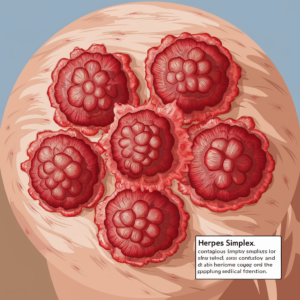
Introduction of the Herpes Simplex Virus
The herpes simplex virus (HSV) is the common cause of herpes simplex. is a frequent infection that can result in excruciating ulcers or blisters. The main way it spreads is through skin-to-skin contact. Although it is treated, it cannot be cured. The herpes simplex virus occurs in two different forms.
Organism Herpes Simplex Virus type 1 and type 2
Types of the herpes simplex virus
HSV-1: Usually, this kind results in oral herpes, which appears as fever blisters or cold sores around the mouth and on the face. On the other hand, oral-genital contact can also result in genital herpes.
HSV-2: This strain is mostly responsible for genital herpes, which causes blisters and ulcers in the vaginal region. But it can also result in genital-oral contact, which can lead to oral herpes.
Herpes simplex virus, both varieties, is extremely contagious and can be spread by direct contact with someone with infected sores, saliva, or genital secretions, even if they are not exhibiting symptoms at the time. Once a person is infected, the virus stays latent in the body and may occasionally reactivate, resulting in recurrent episodes of illness.
Clinical features
The infection may be primary or recurrent.
Primary infections Ulcerative stomatitis (common in infants) keratitis, finger infection, vulvo-vaginitis,balanitis and encephalitis
Recurrent infections These are commonest at the lips and adjoining skin (herpes labialis). Genital lesions also commonly recur.
Treatment
- A mild infection requires no treatment.
- Severe : Acyclovir oral,i/v and eye drops available
Acyclovir, valacyclovir, and famciclovir can aid in lessening the risk of spreading the virus to others and lessening the intensity and duration of outbreaks. It’s crucial for people who have herpes to avoid sexual contact and practice safe sex during outbreaks in order to lessen the possibility of spreading the virus to their partners.